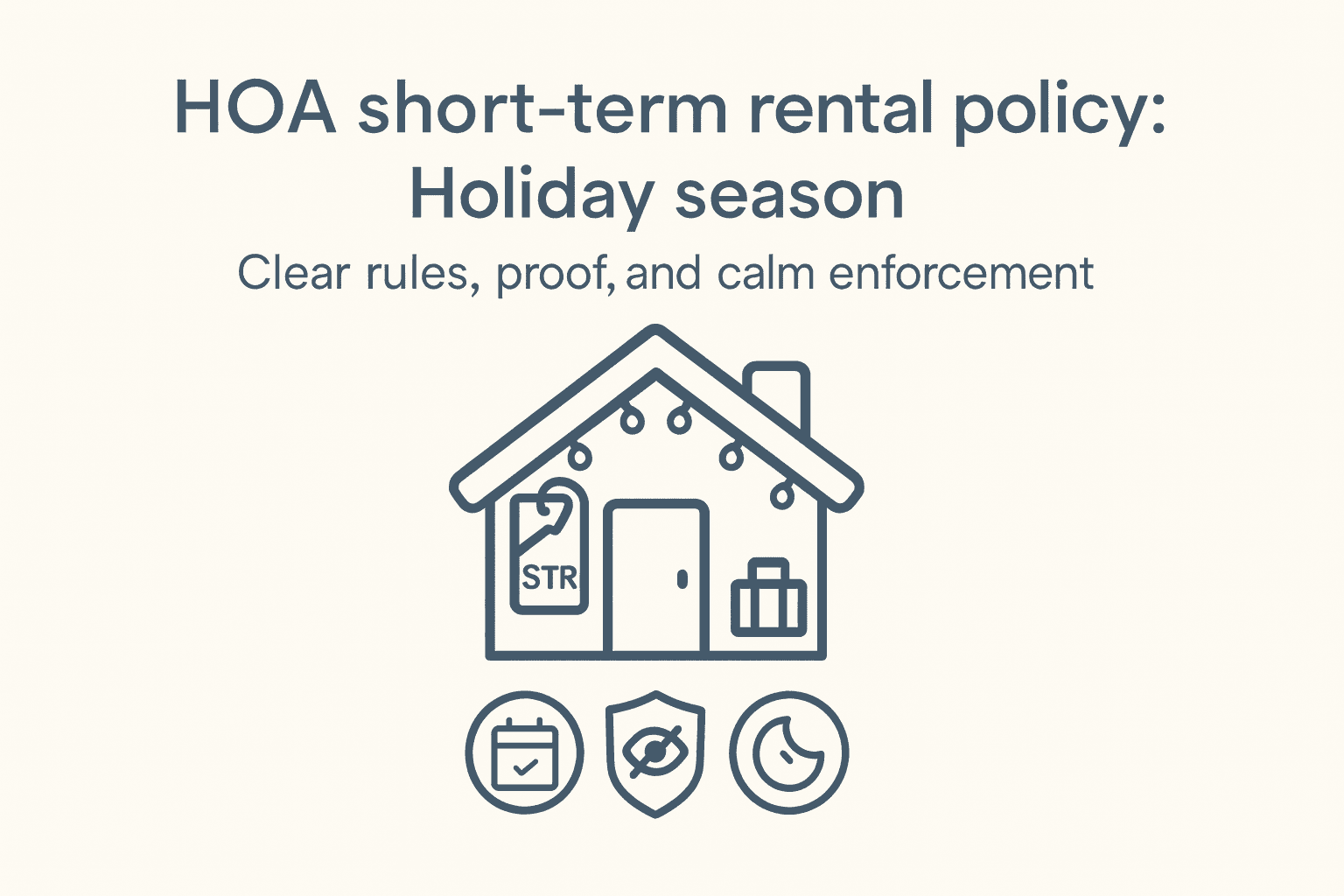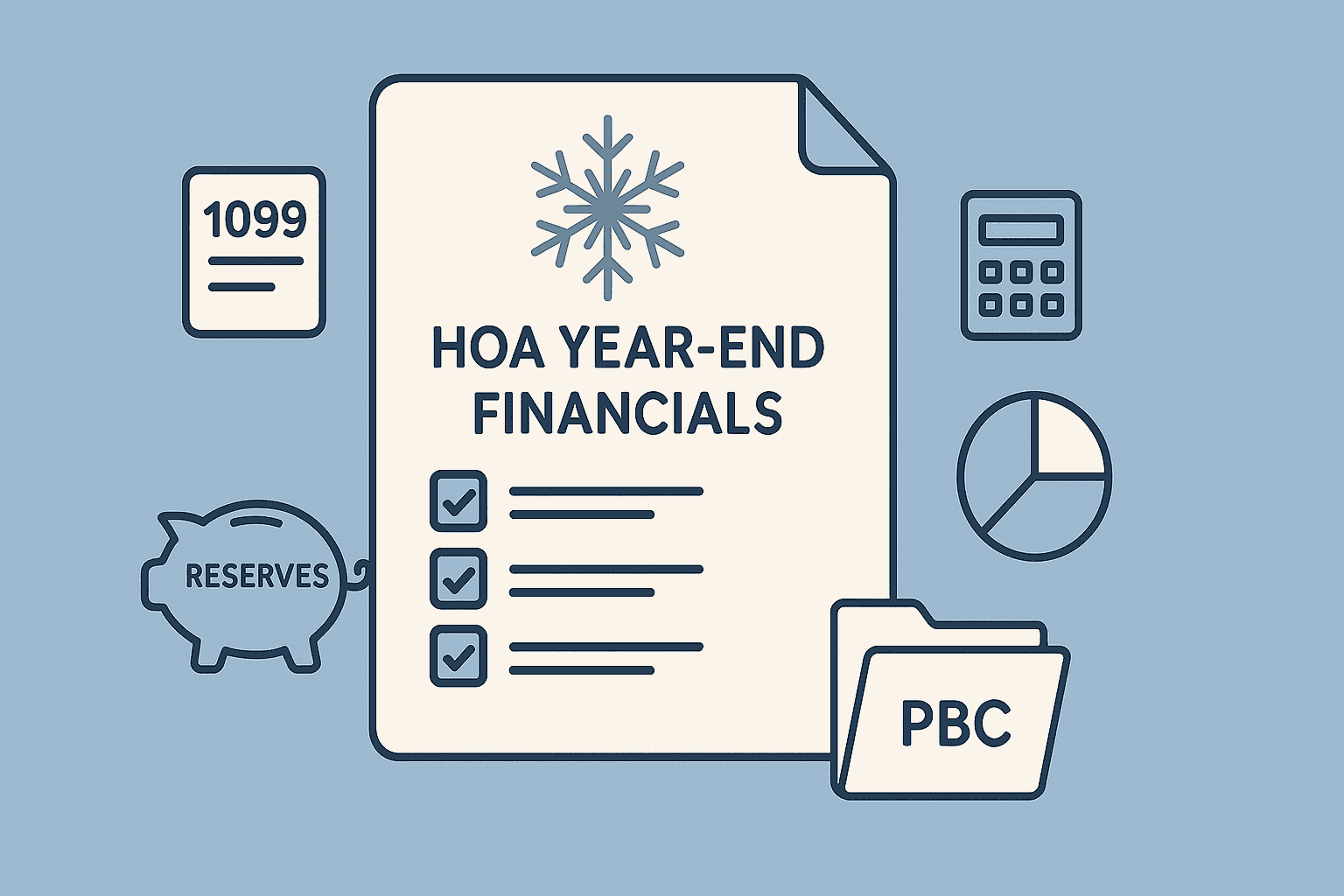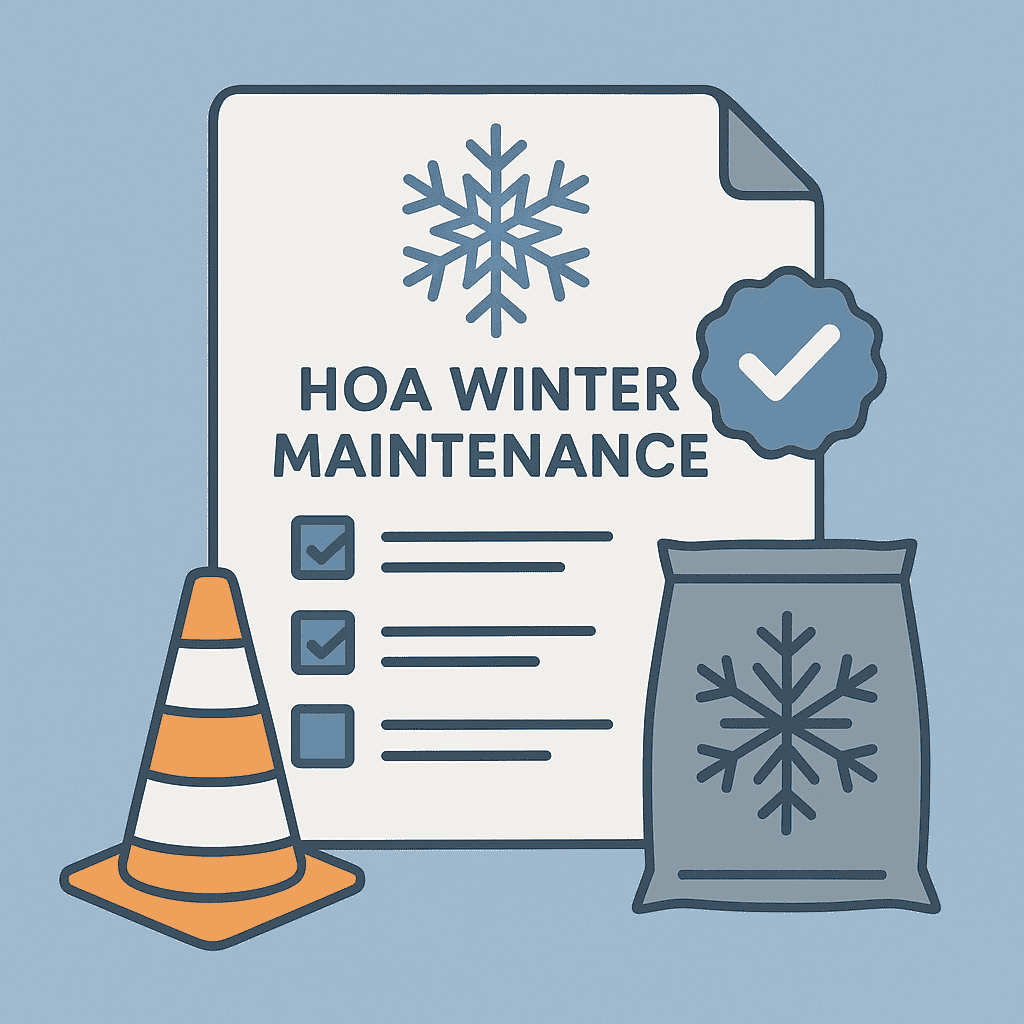How to change HOA bylaws: A step-by-step guide for HOA board members
Changing your HOA’s bylaws might sound like a daunting task, but it doesn’t have to be. In this practical step-by-step guide, we break down exactly how HOA boards can legally and effectively update their bylaws—whether you’re clarifying outdated rules, aligning with state law, or strengthening your community’s governance.

Homeowners association (HOA) bylaws are the internal rules that govern how a community association operates – from board elections and meetings to the powers and duties of the board. Both single-family planned communities and condominium associations rely on bylaws as part of their HOA governance structure. Over time, circumstances change and boards may find that certain bylaw provisions need updating.
How do you change HOA bylaws in a way that is legal, efficient, and beneficial for your community?
This comprehensive guide will walk HOA board members through the process in a calm, instructional tone – no legal degree required.
We’ll cover when and why to amend your bylaws, a clear step-by-step process (applicable across different states), and tips to avoid common pitfalls. By following these guidelines, your board can fulfill its HOA board responsibilities in keeping governing documents current while maintaining homeowner trust.
Understanding HOA bylaws and why they matter
HOA bylaws are one of the core governing documents of a community association, alongside the Articles of Incorporation, CC&Rs (Covenants, Conditions & Restrictions), and any rules and regulations. The bylaws typically establish the association’s structure and procedures – for example, how many board members the HOA has, how elections are held, how meetings are conducted, and the roles of officers. In a condominium association, bylaws serve a similar function, detailing how the condo board and membership make decisions. These rules are legally binding on the association and its members, so it’s crucial that they remain up-to-date and in compliance with current laws.
Over the years, bylaws can become outdated or inconsistent with state statutes. Changes in state HOA or condo laws may override provisions in your existing bylaws, meaning those sections are effectively invalid until updated. For instance, if legislation changed the required notice period for meetings, an older bylaw might conflict with new law. Similarly, community needs evolve – homeowners might push for different quorum requirements, modernized meeting procedures (like virtual meetings), or removal of obsolete developer-era rules. Outdated bylaws can mislead boards about their duties or homeowners about their rights. In short, keeping bylaws current is a key part of good HOA governance.
When and why to amend your HOA bylaws
Amending HOA bylaws is not something to do on a whim – it requires time, effort, and often legal assistance. Before initiating a change, the board should carefully consider the reasons and necessity. Ask yourselves: Why is this bylaw change needed? Is there a problem to solve or a benefit to the community? Proceeding “just because” or without a clear justification is unwise, since changing HOA bylaws is a time-consuming and often financially demanding process. Common reasons to amend bylaws include:
- Compliance with the law: To eliminate provisions that conflict with current state or federal laws or regulations. For example, removing discriminatory language or updating procedures to meet new legal standards (some state laws require a majority vote of owners to amend governing documents and remove illegal covenants).
- Eliminating obsolete or developer provisions: Many HOAs have clauses left over from when the community was built (developer control periods, outdated restrictions, etc.). Once they no longer apply, it’s wise to remove or update them for clarity.
- Addressing community needs: To adjust rules that no longer fit the community’s preferences or lifestyle. Perhaps members want to change rental restrictions, update quorum or voting requirements, or allow modern technologies that old bylaws don’t mention.
- Improving clarity and governance: Fixing poorly drafted sections, clarifying ambiguous language, and making the bylaws more user-friendly (better organization, add headings, etc.) . Good bylaws improve daily HOA governance by reducing confusion.
- Aligning with other documents: Ensuring the bylaws do not conflict with the CC&Rs or Articles of Incorporation. All governing documents should work together consistently.
It’s recommended to review your HOA’s bylaws every 3 to 5 years to identify any needed updates. Regular reviews help catch provisions that have become outdated or non-compliant. If changes are needed, budget accordingly – the amendment process can take many months (often 8–12 months) to complete, from drafting through member approval. It may involve attorney’s fees, printing and mailing costs for notices, and time spent on meetings. By only pursuing amendments that have clear value to the community, the board can justify the effort and expense.
Tip: Before moving forward, check if your bylaws themselves outline a process or threshold for amendments. Many bylaws specify the vote required (e.g. majority of members, or two-thirds) and any procedural steps. Always start by understanding what your current documents mandate for their own amendment.
Step-by-step process to change HOA bylaws
Changing HOA bylaws involves a formal procedure designed to ensure transparency and member participation. While details can vary by state and by your association’s specific documents, the general process will be similar in most U.S. jurisdictions (for both planned communities and condos). In fact, most state laws and HOA bylaws require a vote of the membership to approve amendments – boards usually cannot change bylaws unilaterally. Below is a step-by-step guide to amending your bylaws, from the initial idea to final adoption:
A well-organized amendment process helps HOA boards implement changes smoothly. The following steps outline how to change HOA bylaws while keeping your community informed and involved.
- Review current documents and laws: Begin by thoroughly reviewing your current bylaws and any other relevant governing documents (CC&Rs, Articles). Identify the sections you believe need change and note what the bylaws themselves say about the amendment process (e.g. required vote percentages or quorum). If the bylaws are silent on how to amend them, consult your state’s nonprofit corporation act or HOA/condo act for default rules. For instance, some state laws provide a default procedure or require member approval if the documents don’t specify. It’s also wise at this stage to review state law requirements (notice periods, voting methods, recordation) that might apply to bylaw amendments so you know the legal framework you must follow.
- Draft a clear amendment proposal: Develop a formal written proposal for the bylaw change. This can be drafted by the board or a committee (often with the help of an HOA attorney to ensure proper wording). The proposal should state the exact changes to be made (referencing article/section numbers in the bylaws) and the rationale behind each change. Being precise and clear is important – homeowners will want to know what is changing and why. Use clear language and try to maintain a tone consistent with the rest of the bylaws (for cohesiveness of the document). If you are amending multiple sections, consider preparing a summary or a redline version of the bylaws to show before-and-after text, which can help members understand the proposal.
- Board review and approval: Next, the HOA board of directors should review the proposed amendment in a board meeting. In many HOAs, the board must formally approve moving the amendment forward before it goes to a membership vote. During this discussion (which may occur at a regular board meeting or a special meeting called for this purpose), board members can debate the merits of the change, suggest edits, and consider member feedback. Importantly, this meeting should be open to all homeowners so they can hear the discussion and provide input or ask questions. Transparency early in the process helps prevent confusion or suspicion later. Some boards even hold an informational forum or send a draft to owners for comment prior to the official vote – though not required, this can build support and surface concerns to address. Once the board is satisfied, they can vote to proceed with a member vote on the amendment.
- Provide notice to homeowners: Proper notification to all HOA members is a critical step that is often legally required. Notify homeowners in advance that a vote on bylaw amendments will take place. This notice is typically given as part of announcing a member meeting (often the annual meeting or a special meeting called for the amendment vote). Follow the notice requirements in your bylaws or state law – for example, many states require notice be mailed (or emailed if the owner has agreed) at least 10 to 30 days before the meeting. The notice should include the text of the proposed amendment or a summary, an explanation of why the change is being proposed, and details about when and how the vote will occur. Clear communication here is vital: homeowners should have sufficient time to review the proposal and make an informed decision. Failing to give proper notice can invalidate the vote and lead to legal issues, so double-check that your notice meets all requirements.
- Hold a membership vote: At the designated meeting (or via written ballot process if allowed), the association’s members vote on whether to approve the bylaw amendment. In most HOAs and condo associations, a member vote is required to change the bylaws, with a certain approval threshold that could be a simple majority or a super-majority (read more about voting rules here). Your bylaws will specify the needed threshold; commonly it may be two-thirds or even three-quarters of members in favor to pass. Ensure you have a quorum of members represented at the meeting (in person or by proxy or absentee ballot, as your rules allow) before conducting the vote. Voting can be done by raising hands, written ballots, or electronic voting, but be aware of any state-specific rules here. For example, California law requires the use of secret paper ballots for member votes on bylaw amendments. Make sure to also note any other legal requirements during voting, such as whether proxies are allowed or if a mortgage lender consent is needed for certain changes (some older governing documents require lender approval for amendments, though this is more common for CC&Rs than for bylaws). The process must be conducted fairly and in accordance with your governing documents and applicable law.
- Count the votes transparently: Once votes are cast, count the ballots in an open and transparent manner. It’s good practice (and in some states, required) to count the votes during an open session where observers (homeowners or candidates) can watch. This openness builds trust in the outcome. Tally the votes carefully and have at least two individuals verify the counts. If your HOA allows ballots to be counted by an independent committee or an election inspector, follow those procedures. After counting, announce the results to the members. The outcome will determine the next step. If the required threshold was met – congratulations, the amendment is approved! If not, the amendment fails (or you may have the option to extend the voting deadline or pursue additional votes, if your bylaws permit). Always document the vote counts in the meeting minutes for the association’s records.
- Formalize the amendment (record and adopt): With a successful member vote, the bylaw amendment can be officially adopted and integrated into your governing documents. In the case of bylaws, usually the change becomes effective immediately upon the vote or at a time stated in the amendment (no external filing is typically required for bylaws). However, for CC&R amendments (covenants), it’s usually required to record the amendment with the county recorder’s office to put the change on the public record. Bylaws generally do not need to be recorded with the county, but do check your state’s laws – for instance, some condominium acts may require filing bylaw changes with the state or a state agency. After the vote, the board should prepare the final amended text: incorporate the approved changes into the bylaws document. Often, the board president or secretary will sign a certification of the amendment, and if needed, have it notarized and recorded (again, typically only for covenants or condo documents, not standard bylaws). If your state or bylaws required any sort of certification (like the secretary certifying that the amendment was duly adopted by the required vote), complete that step now.
- Notify the membership and distribute updates: The final step is to communicate the successful amendment to all HOA members and provide them with the updated bylaws. All owners should get a copy of the revised bylaws (whether as a printed document, via email, or through a community website or portal). Many HOAs will send a letter or email stating, “The amendment to the bylaws was approved by the membership on [date]. Enclosed is an updated copy of the bylaws for your records.” Transparency doesn’t end with the vote – homeowners should be fully informed that the change is now in effect. Going forward, keep the amended bylaws accessible (for example, provide them to new homeowners, and give copies to any prospective buyers who ask). Internally, ensure that the board’s reference binders, digital files, and any state corporate filings (if they require listing of governing documents) are updated. By properly documenting and circulating the new bylaws, the association will operate under the correct rules and avoid any confusion about what rules are current .
By following these steps in order, an HOA board can systematically guide a bylaw change from start to finish. Remember that adhering to the proper procedure is not just a formality – it’s a legal requirement. If you shortcut a step (for example, not providing adequate notice or failing to meet the required vote threshold), the amendment could be challenged as invalid. When in doubt, consult your association’s attorney to ensure every box is checked.
Tips and best practices for amending bylaws
Changing your HOA’s bylaws can be challenging, but these best practices will help the process go more smoothly and improve your chances of success:
- Ensure the change is necessary: Before launching into the amendment process, double-check that the change is truly needed and beneficial. Unnecessary changes waste effort and can create division. If most homeowners are content with the status quo, consider whether the issue can be addressed through a policy or rule instead. Amend bylaws only for good reason – such as legal compliance or clear community benefit – not personal preferences .
- Educate and communicate early: One of the common pitfalls is not bringing homeowners along from the start. It’s wise to informally gauge owner support before the formal vote. Explain the problem the amendment will solve or improvement it will bring. Perhaps hold a town hall Q&A or send a memo explaining the proposal in plain language. Early communication helps prevent misinformation and builds trust. Throughout the process, maintain clear communication about each step (notice of meetings, what is being voted on, results, etc.). An informed community is more likely to support the change.
- Follow your governing documents to the letter: This may sound obvious, but many HOAs falter by overlooking a procedural requirement. Read the amendment provisions in your bylaws and declaration carefully. Note exactly what percentage of votes is needed (is it of those present, or of the entire membership? Does it include both members and their mortgagees?), and any special procedures like multiple readings or notarization. Also check if your articles of incorporation or state law give any default rules. For instance, in some jurisdictions the board may have the power to amend bylaws unless the bylaws reserve that power to members . In other cases, state law may allow boards to eliminate illegal discriminatory language without a member vote . Know the rules that apply so you don’t unintentionally overstep or skip something crucial.
- Consider legal counsel: Involving an HOA attorney is highly recommended, especially for significant amendments. A lawyer experienced in community association law can help draft the amendment in proper legal language, ensure it aligns with state law and other governing documents, and guide the board on procedure. Yes, it’s an added cost, but it’s often more costly to fix a botched amendment after the fact. An attorney’s guidance can prevent proposing an amendment that is illegal or conflicts with your declaration (which would make it void even if passed). They can also provide the required legal opinion if your board plans to update bylaws without a member vote in an emergency, where allowed by law or executive order (this was an issue some HOAs faced during pandemic meeting restrictions). In short, legal counsel helps “future-proof” your amendment and process.
- Leverage state resources and templates: For additional help, look for resources provided by state HOA offices or reputable organizations. Some states publish HOA/condo guidebooks or have ombudsman offices with information on amendments. The Community Associations Institute (CAI) and its local chapters offer educational materials on amending governing documents (for example, CAI’s public policy supports laws to simplify removing illegal covenants). While you should be cautious with generic templates, reading guides from nonprofits or state agencies can give you a clearer picture of best practices in your state. Always tailor any template to fit your community’s specific documents and legal requirements.
- Plan for member turnout: One of the biggest challenges in passing bylaw amendments is simply getting enough homeowners to participate. Low voter turnout can doom an amendment, especially if a super-majority is required. To combat this, treat the amendment vote like a campaign: send reminders, encourage proxy voting if allowed, and perhaps offer multiple ways to vote (in-person, absentee, electronic) in accordance with your bylaws and state law. If your initial meeting fails to meet quorum, check if your bylaws allow an adjourned meeting with a lower quorum or some alternate approach. Persistence and outreach are key. Some HOAs have success by door-knocking or phone banking reluctant voters in the final days before the deadline.
- Maintain transparency and fairness: Throughout the process, conduct yourselves with the highest integrity. Count votes in an open meeting with observers, as noted earlier, to bolster confidence in the results. If homeowners voice concerns or opposition, listen respectfully – you may even discover valid points that lead to adjusting the proposal. By demonstrating that the board is acting in the community’s best interest and following all rules, you reduce the risk of anger or legal challenge. Transparency is not just ethical, it’s practical: it helps get that “yes” vote from skeptical members.
- Document everything: Keep careful records at each step. Save copies of the notice sent to owners, minutes of meetings where the amendment was discussed, the vote tally sheet, and the final text of the amendment. If there’s ever a dispute about whether the amendment was validly adopted, these records are your evidence that the process was done correctly. After adoption, ensure the official records of the association are updated – store the new bylaws with the association’s important documents and perhaps have the board pass a resolution stating that the bylaws have been amended as of the vote date. Proper record-keeping is part of the board’s fiduciary duty and will make future transitions (like new board members or management companies) much easier.
Common Pitfalls to Avoid
Even well-intentioned boards can run into trouble when amending bylaws. Here are some common pitfalls and mistakes to avoid:
- Skipping the attorney review: Trying to save money by not consulting an HOA attorney can backfire if the amendment language is flawed or unenforceable. An ambiguous or illegal amendment might lead to disputes or even court battles later. Don’t fall into the trap of DIY legal drafting for critical documents.
- Not meeting the required vote threshold: Be very clear on what constitutes approval. For example, if your bylaws say “two-thirds of the entire membership” must approve, getting two-thirds of those who show up at a meeting is not enough – you’d need two-thirds of all owners. Many amendment efforts fail because the board misreads the requirement or fails to get enough ballots returned. If the vote falls short, the bylaws are not changed, no matter how close the tally. Avoid the pitfall of declaring victory without legally sufficient votes; doing so could lead to legal issues and member challenges.
- Improper notice or procedure: Rushing the process and neglecting notice periods, quorum rules, or other procedural steps can invalidate the amendment. Always give notice as required (and it’s better to err on the side of more notice rather than too little). If your bylaws require, say, 30 days notice and a written copy of the proposed amendment to each member, make sure you do exactly that. The same goes for holding the meeting correctly – for instance, if a special meeting is required, don’t try to piggyback the vote onto an unrelated gathering without proper notice. Courts have overturned HOA votes when procedures weren’t followed strictly.
- Ignoring member feedback and pushback: If you sense significant resistance from homeowners, don’t bulldoze through it. Homeowner pushback is a real obstacle. Sometimes boards propose amendments that are too controversial (like very strict rental caps or pet bans) and face angry opposition. It’s better to pause and engage with members’ concerns, possibly revising the proposal, than to forge ahead and have the amendment voted down or create bad blood in the community. Remember, the goal is to improve the community, and that requires buy-in.
- Conflicts with higher documents: Ensure that your bylaw amendment does not conflict with the declaration (CC&Rs), articles of incorporation, or any higher authority. For example, if the CC&Rs require a 75% vote to amend any “governing document,” you cannot use a lower threshold stated in the bylaws to bypass that – the stricter requirement governs. Likewise, bylaws cannot override state law. Any amendment that contradicts a law or the CC&Rs will be void even if members vote for it. This is why legal review is important. Keep the hierarchy of documents in mind: State law -> Declaration -> Articles -> Bylaws -> Rules, generally, with state law and the declaration taking precedence.
- Lack of recordation (if required): While most bylaws changes don’t need to be recorded with the county, if your state or governing documents do require filing and you neglect it, the amendment might not be effective. This is more pertinent to CC&R amendments, but double-check. For instance, Florida HOA covenants must be recorded to be enforceable, and some condo bylaws might be required to be officially filed. Missing that step keeps the old bylaws technically in force.
By being mindful of these pitfalls, your board can avoid costly do-overs or disputes. Learning from other HOAs’ experiences – such as the common hurdles of low turnout or conflicts over contentious amendments – will make your own journey smoother.
Final Thoughts
Yes, an HOA can change its bylaws, but as I’ve shown, it’s a process that should be approached thoughtfully, methodically, and in compliance with all requirements. Amending your HOA bylaws is part of the board’s responsibility to adapt governance to current needs, but it must be done with care for both the legalities and the community’s harmony. Always keep in mind that HOA bylaws are the foundation of your association’s operations and “the cornerstone of community living,” so changes should aim to enhance the community’s well-being and not be taken lightly.
For HOA board members across the U.S., the steps outlined above provide a reliable roadmap. While details may vary by jurisdiction – for example, the exact percentage of votes needed or specific notice formats – the overarching principles of review, proposal, member involvement, and formal approval hold true everywhere. When in doubt, seek guidance from professionals or reputable resources. Organizations like the Community Associations Institute (CAI) offer education for HOA boards, and many states have helpful manuals or websites for HOA law. Also, don’t underestimate the value of experienced fellow board members or community association managers who have been through amendments before.
By following proper procedures, engaging your homeowners, and adhering to legal and ethical best practices, your HOA can successfully amend its bylaws to meet the community’s evolving needs. The result will be governing documents that are current, enforceable, and reflective of your community’s values. And achieving that is a victory for good HOA governance.
Anyhoa is dedicated to helping HOA boards navigate questions like these. We hope this guide has demystified the bylaw amendment process. With patience, transparency, and diligence, you can lead your association through a bylaw change that strengthens your community for years to come. Good luck with your amendment, and remember – your homeowners’ support and understanding are the keys to making it a success!
Sources
- FirstService Residential – Navigating HOA Bylaws: Can your HOA change its bylaws?
- Cedar Management Group – How Can an HOA Amend Bylaws and Covenants Legally?
- HOA Management – How to Change HOA Bylaws, Covenants, and Rules
- AZ Big Media (Patrick R. MacQueen, Esq.) – How to amend HOA CC&Rs or bylaws in 4 steps
- HOAresources (CAI) – Removing Racially Discriminatory Rules in Governing Documents
Educational Community for Homeowners (ECHO) – Amending Your HOA’s Governing Documents






